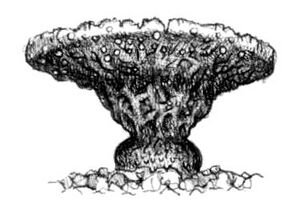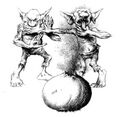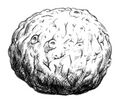Fungus
Fungi (the plural of Fungus) are a species of eukaryotic organisms, which means that they're not plants or animals, but their own unique order of life. In real life, they cover a vast array of organisms, from humble yeast to the more iconic molds, mushrooms and toadstools. In fantastical universe, fungi can grow into forms very unlike anything on Earth.
D&D Fungi
In Dungeons & Dragons, the humble fungus has long been a supporting character throughout the editions. At its most basic, you have exotic background fungi, such as tree-sized mushrooms in the Underdark, with many species of edible, poisonous or even magical fungi often showing up in articles on the Underdark. Other fungi are even more spectacular, or at least memorable, because they can try to kill your adventurers.
Violet Fungi are semi-ambulatory mushrooms that actively hunt living creatures, lashing out with toxic, flesh-rotting tendrils to kill and consume prey.
Shriekers are semi-ambulatory mushrooms that are harmless... in the way that a burglar alarm is harmless unless you trip it. If these things bump into something, they scream. Very, very loudly. And whilst they can't hurt you, anything that hears the screaming and comes to investigate probably isn't so non-hostile.
Phycomids are slithering carpet-like masses of predatory fungus that spew caustic alkaline goop at living creatures, seeking to kill them and feast on their flesh.
Ascomoids are essentially puffballs. Just... grown to gigantic size. And semi-self-mobile. And hungry to chase down living cretures and squash them to a pulp to feed on their rotting flesh. So, actually, not all that much like puffballs really.
Gas Spores are infamous as one of the damn cheapest of D&D's long and sordid history of "Gotcha Monsters!" These toxic puffballs are full of lighter-than-air gas, which sends them floating around the place. And they just so happen to resemble the dreaded beholder. Exactly why has never really been explained in most editions, although 3.5's came pretty close to a satisfactory one by saying they were created as expendable decoys by beholder mages. In 5th edition, they're a magical fungus that grows on beholder corpses, and if you survive exposure to the toxic spores, you'll pick up fragmented memories of the beholder they originated from.
Cushion Fungi, introduced in Dragon Magazine #172, are enormous carnivorous mushrooms that resemble plush cushions. They secrete soporific spores when they sense living creatures, causing the weak-willed to take a nap on the "cushion", which then smothers them before digesting their corpse. A fine example of Old School Roleplaying and the tradition of "Gotcha Monsters!"
Vermeil Fungi are native to the Savage Coast of Mystara, and supposedly are related to gas spores. Taking the form of large, crimson mushrooms, these fungi explode in a thick red cloud that resembles vermeil when disturbed - worse, this has the same effect on cinnabryl as detonating smokepowder, allowing their toxic spores to spread the debilitating effects of the Red Curse.
Sargusian Fungi, commonly and inaccurately referred to as "Dirtwraiths", are a species of semi-intelligent predatory fungus native to the [[[Abyss]], but which can also be found in the Vesve Forest of Greyhawk, a result of a Bonehart wizard unwittingly bringing spores back with him after a trip to the Abyss and then accidentally sowing them around Delaquenn. This fungus attaches itself to plants and animates them, using them as weapons to kill living creatures so it can feed on their corpses. Demons love the stuff, they think it's a delicacy, but it's lethally poisonous to mortals.
Egarus, also known as Vacuum Fungus, is a voraciously energetic strain of fungus native to the Quasielemental Plane of Vacuum, which has the distinct and unpleasant habit of rapidly growing on - and disintegrating - any form of matter, inanimate or not.
Myconids, also known as Fungus Men, are a race of sapient, humanoid mushrooms native to the Underdark.
Campestri are a devolved, dimwitted, surface-dwelling, music-loving relative of the Myconids.
Vegepygmies, also known as Mold Men, are fungus-based humanoids that grow out of the bodies of people consumed by the alien fungus called Russet Mold.
40K Ork Fungi

Since Orks share an affinity with fungus, it is of no surprise that within the Ork eco-system one of the most vital aspects that keep Ork society going is the growth of specialized 'Orkoid Fungus'. If anything, every single Orkoid species from the lowliest Snotling to the greatest Squiggoth both come from the same fungal spore. Only changing via chemical or hormonal stages when the Orkoid is gestating. Ork spores grow in the wilderness, giving birth to new forms of Orkoid life. Different forms of Orkoid Fungus play essential roles in Ork society. Ork Settlements are surrounded by great patches of the fungi. Cultivated by Snotlings and eaten by Eating Squigs, they are a primal source of food in Ork society.
Gretchin cooks usually turn some Fungus into something fancy. Examples include Fungus Beer, Fungus Wine, Fungus Chips as well as potentially making Mashed Fungus, Poached Fungus, Baked Fungus Pie and etc.
Here are some types of Orkoid fungus identified by the Imperium.
Puffball
These round fungi contain huge amounts of poisonous spores, which are released after they are broken or crushed. Snotlings use them as primitive fungus bombs, dropping them under the feet of an enemy. After they step on it, they will have to suffer a nasty whiff of toxic spores which gives the Snotlings some actual use in the battlefield other than meatshields or ammunition.
All Orkoids are immune to these spores, they only make them cough and gag. Puffballs cleaned of spores and stuffed with marinated Squig meat is a popular Ork meal as the fungus enhances the already flavor-riched Squig to a new level. Spores collected from a different varieties of Puffballs are used to make Fungus Gas Bombs and for various medical uses.
Speckled Bloodshade Fungus
In appearance the Speckled Bloodshade is a deep red or purple fungus speckled with yellow or green flecks. It can be eaten by Orks and has important medical uses due to to its effect on the Ork bloodstream. This fungus is rich in molds in spores found in Ork blood and skin, so it can be used to enrich the blood to speed up the Ork metabolism, usually in fungus juice injection cylinders. It is also used to slow the flow of blood which is a great benefit in treating wounded Orks.
Mushlings and Snotrooms
This is what happens when a Snotling dozes off too much in the Fungal gardens. As Snotlings feed primarily on fungus, often eating as much as they can. This in turn can lead to strange side effects, one of which is becoming a fungoid. Snotlings start to become lazy and feckless and eventually vegetate at the side of the drop, tuning into a Snotroom or Mushling; a fungus preserving the vestige of a Snotling face. These are usually eaten only on festive occasions, as they become tough and large.
Rutted Gob-Buster
This fungus can grow very large and it becomes quite hard to eat a big one in one go, hence its name. Gob-Buster has a tough texture and strong spicy tang. Big and old ones are so strong Orks sometimes have to spit them out. Some Orks consider finishing a Gob-Buster a demonstration of self-endurance. On the other hand, their spicy and tangy flavor is used by Gretchin cooks to further enhance the flavor of Squig meat or other mushrooms.
Other
Other types of fungus also appear but are overall too minor to be properly described other than they're all edible.
- Pink-Spotted Trottlecap
- Warted Nightbloomer
- Heartburn
Gallery
-
Puffballs and no, those Snotlings aren't having a great old time.
-
An Ork sitting on a Mushling/Snotroom.
-
The Gob-Buster, harder than a bowling ball but tastier than most mushrooms today.


